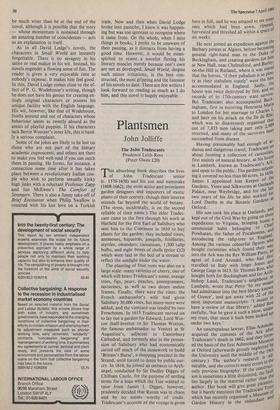Plantsmen
John Jolliffe
The John Tradescants Prudence Leith-Ross (Peter Owen £20)
This absorbing book describes the lives
of John Tradescant senior (c. 1570-1638) and his son and namesake (1608-1662), the most active and prominent garden designers and importers of exotic plants of their century, though their interest extends far beyond the world of botany. (The stress, incidentally, is on the second syllable of their name.) The elder Trades- cant came to the fore through his work at Hatfield for the first Earl of Salisbury who sent him to the Continent in 1610 to buy plants for the garden: they included roses, anemones, hepaticas, jonquils, fritillaries, myrtles, oleanders, carnations, 1,300 tulip bulbs, and eight boxes of shells (price £12) which were laid in the bed of a stream to reflect the sunlight under the water.
The planting of fruit trees was also on a large scale: many varieties of cherry, one of which still bears Tradescant's name, orange trees, figs, pears, peaches, pomegranates, nectarines, as well as two dozen melon frames. Finally, there were the vines: the French ambassador's wife had given Salisbury 30,000 vines, but many more were added, and the vineyard was tended by two Frenchmen. In 1615 Tradescant moved on to lay out a garden for Edward, Lord Wot- ton (half-brother to Sir Thomas Wotton, the famous ambassador to Venice) at St Augustine's, adjacent to Canterbury Cathedral, and formerly also in the posses- sion of Salisbury who ' had economically carted off much of the stonework to build 'Britain's Burse', a shopping precinct in the Strand, until forced to desist by public out- cry. In 1618, he joined an embassy to Arch- angel, conducted by Sir Dudley Digges of Chilham Castle, for the purpose of settling terms for a loan which the Tsar wanted to raise from James I. Digges, however, prudently decided that Russia was in chaos and by no means worthy of credit. Tradescant's account of the voyage is given here in full, and he w
oats which had been sown, ripened, was amazedasmpeeatzactdurt 07 Aseperripened,e 4 harvested and threshed all within a space 0't six weeks.
He next joined an expedition against the Barbary pirates at Algiers, before becoming general right-hand man to the Duke of Buckingham, and creating gardens for hire at New Hall, near Chelmsford, and Burley on-the-Hill in Rutland, where it was stated that the horses, 'if their pabulum is so Plen- ty as their stabulum stately' were the best accommodated in England. Sadly, the house was twice destroyed by fire, and no records of its 17th-century state survive. But Tradescant also accompanied Buck- ingham, first in escorting Henrietta Maria to London for her marriage to Charles I, and later on his attack on the Ile de Rile' which was so disastrously organised that out of 7,833 men taking part only 2,989 returned, and many of the survivors later succumbed from disease. Having presumably had enough of at" duous and dangerous travel, Tradescant set about forming a collection of curiosities, first mainly of natural history, at his house in Lambeth, known as Tradescant's Ark, and open to the public. The gardens adjoin' ing it covered no less than 60 acres. In 1630' James I appointed him Keeper of 111,e Gardens, Vines and Silkworms at Oatlands Palace, near Weybridge, and for the last two years of his life he also worked for Lord Danby at the Botanic Gardens at Oxford. His son took his place at Oatlands, and kept out of the Civil War by going on three expeditions to Virginia, bringing h Chief ceremonial habit belonging to CA Powhatan, the father of Pocahontas, artrii" introducing the tulip-tree to Euglarikci Among the various colourful figures wu bought curiosities which found their waY into the Ark was the Rev William Petty' afit agent of Lord Arundel, who had firs. travelled to Italy with Inigo Jones and George Gage in 1613. Sir Thomas Roe, Arch: neighbour at Lambeth, wrote that Petty 'by InY means had admittance into the best library kaci`vbe of Greece', and got away with 22 of to most important manuscripts. `1 rueant-e have a review of that library,' addedi7r ruefully, 'but he gave it such a blow, unele,., under ss.ince since hath been locked aB 0 An unscrupulous lawyer, Elias Ashr0,1ee'r acquired the contents of the Ark all Tradescant's death in 1662, and they forth_ ed the basis of the first Ashmolean Muse.u: at Oxford (afterwards grossly neglectecal19vti; ctheeUurniversity until the middle of the nt „,.1- Y.) The author's research is mirable, and she corrects many errors inuw_t_ only previous biography. If the constr.. ..clt ion is sometimes a little disjointed, the ta" lies largely in the material rather thanutrhee, author. Her book will give great Plea .,st _s but it barely mentions the Tradescant ruor which has recently organised a Museurri_d Garden History in the redundant an derelict Church of St Mary's, Lambeth. Many Spectator readers will no doubt be in- terested in becoming Friends of the Trust and in enjoying an excellent series of exhibi- tions, talks, concerts etc which runs from 3 March to mid-September. They should app- ly to the Chairman, Mrs John Nicholson, 7, The Little Boltons, London SW10.











































 Previous page
Previous page